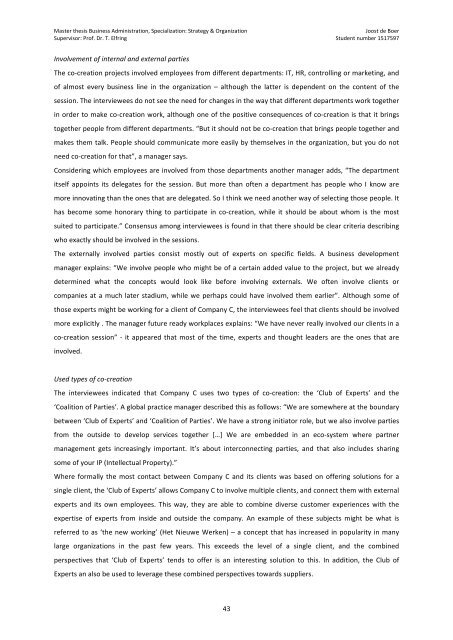Download PDF (English) - Future Ideas
Download PDF (English) - Future Ideas
Download PDF (English) - Future Ideas
Create successful ePaper yourself
Turn your PDF publications into a flip-book with our unique Google optimized e-Paper software.
Master thesis Business Administration, Specialization: Strategy & Organization <br />
Supervisor: Prof. Dr. T. Elfring <br />
Joost de Boer <br />
Student number 1517597 <br />
Involvement of internal and external parties <br />
The co-‐creation projects involved employees from different departments: IT, HR, controlling or marketing, and <br />
of almost every business line in the organization – although the latter is dependent on the content of the <br />
session. The interviewees do not see the need for changes in the way that different departments work together <br />
in order to make co-‐creation work, although one of the positive consequences of co-‐creation is that it brings <br />
together people from different departments. “But it should not be co-‐creation that brings people together and <br />
makes them talk. People should communicate more easily by themselves in the organization, but you do not <br />
need co-‐creation for that”, a manager says. <br />
Considering which employees are involved from those departments another manager adds, “The department <br />
itself appoints its delegates for the session. But more than often a department has people who I know are <br />
more innovating than the ones that are delegated. So I think we need another way of selecting those people. It <br />
has become some honorary thing to participate in co-‐creation, while it should be about whom is the most <br />
suited to participate.” Consensus among interviewees is found in that there should be clear criteria describing <br />
who exactly should be involved in the sessions. <br />
The externally involved parties consist mostly out of experts on specific fields. A business development <br />
manager explains: “We involve people who might be of a certain added value to the project, but we already <br />
determined what the concepts would look like before involving externals. We often involve clients or <br />
companies at a much later stadium, while we perhaps could have involved them earlier”. Although some of <br />
those experts might be working for a client of Company C, the interviewees feel that clients should be involved <br />
more explicitly . The manager future ready workplaces explains: “We have never really involved our clients in a <br />
co-‐creation session” -‐ it appeared that most of the time, experts and thought leaders are the ones that are <br />
involved. <br />
Used types of co-‐creation <br />
The interviewees indicated that Company C uses two types of co-‐creation: the ‘Club of Experts’ and the <br />
‘Coalition of Parties’. A global practice manager described this as follows: “We are somewhere at the boundary <br />
between ‘Club of Experts’ and ‘Coalition of Parties’. We have a strong initiator role, but we also involve parties <br />
from the outside to develop services together […] We are embedded in an eco-‐system where partner <br />
management gets increasingly important. It’s about interconnecting parties, and that also includes sharing <br />
some of your IP (Intellectual Property).” <br />
Where formally the most contact between Company C and its clients was based on offering solutions for a <br />
single client, the ‘Club of Experts’ allows Company C to involve multiple clients, and connect them with external <br />
experts and its own employees. This way, they are able to combine diverse customer experiences with the <br />
expertise of experts from inside and outside the company. An example of these subjects might be what is <br />
referred to as ‘the new working’ (Het Nieuwe Werken) – a concept that has increased in popularity in many <br />
large organizations in the past few years. This exceeds the level of a single client, and the combined <br />
perspectives that ‘Club of Experts’ tends to offer is an interesting solution to this. In addition, the Club of <br />
Experts an also be used to leverage these combined perspectives towards suppliers. <br />
43





